Academic Reviews
Academic Review - The Voices of Morebath
February/23/2017 11:08 PM
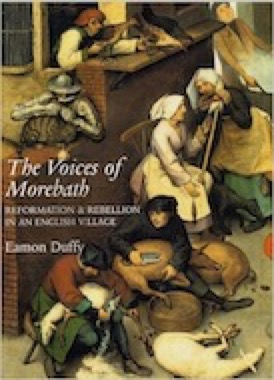
Author: Eamon Duffy
(Yale University Press)
The Voices of Morebath: Reformation and Rebellion in an English Village
Eamon Duffy interprets the words of Sir Christopher Trychay, a Catholic priest who holds a tiny English village together during the Reformation. Published in 2001 by Yale University Press, this detailed account of events in Morebath provides primary documentation along with secondary analysis. Although limited to one small part of England, comprehension of the religious upheaval that took place on a larger scale is possible by examining the lives of a few.
What makes Trychay unusual is his ability to work with Catholics and Protestants. He started as a Catholic, abided by changes implemented during the Reformation at the time of King Henry VIII, converted back to Catholicism during the reign of Queen Mary, and returned to Protestantism when Queen Elizabeth took the throne. He strove to prevent bloodshed and unnecessary heartache.
This priest kept extensive financial records. Every transaction, everything added or removed from the church, he wrote down. Trychay kept track of births, baptisms, marriages, and deaths as well, but his focus remains a monetary one.
When Catholicism was at its peak, religious art thrived. Burglaries were common, and Trychay’s church was no exception. Tributes paid for by members of his parish adorned the interior. As insignificant as Morebath seems in comparison to a large city, its problems were similar—less to steal and fight over, yet enough to cause trouble for residents. Patrons would donate an item to the church only to see it removed.
Suppression of idolatry, known as iconoclasm, resulted in the confiscation of statues, sculptures, paintings, and trinkets with symbolic meaning that Protestant authorities found questionable. Catholics of the 1500s were superstitious as well as artistic. Since church and government were intertwined, deifying a person or an object could be considered a crime. Refusal to comply with a mandate might result in death.
Trychay cooperated with the dictates of the monarch in charge, but people in his parish recoiled as Reformation orders were carried out. On a philosophical level there would never be agreement. On a legal level there could be cooperation as long as an educated minority made the decisions.
“We are forever shut out from all but the surface of Morebath’s religion,” Duffy writes. “Late medieval Christianity moved between distinct but complimentary poles—public and private, the religion of the liturgy and the religion of the heart.”
Catholics discouraged the education of anyone but the controlling elite because authorities feared the influence of outsiders would change the status quo. The Reformation was an underground movement, and no one knew for certain where a person’s sympathies lay. Protestants encouraged education and transformation. Sudden involvement of so-called underdogs threatened the establishment.
Duffy emphasizes the significance of worshipping in English rather than Latin. The liturgy was now understandable to the average villager. The church remained the focus of their existence, the glue that held their community together. Religious turmoil meant personal turmoil, even to the point of psychological disturbance and violence. Resistance to the Reformation may have been aversion to change as much as rebellion against Protestantism.
Humiliating and punishing women to control objectionable behavior Duffy describes as “a coarsening of social fibre.” Protestants allowed a woman more power and autonomy, while Catholics placed her on a maternal pedestal, a symbol of nurturing, subdued perfection. Abusive men likely had difficulty adjusting to the elevation of a woman’s status beyond her traditional roles as wife and caregiver.
Duffy presents his research well, sharing his knowledge without an overwhelming excess of detail. His admiration for Sir Christopher Trychay is apparent. While remaining sympathetic to the persecution of Catholics, he criticizes counter-Reformation rebellion. Protestants and Catholics have the right to exist side by side. His text is a worthwhile study of Renaissance theological history.
Academic Review - The Elizabethan Renaissance
February/13/2017 01:37 PM
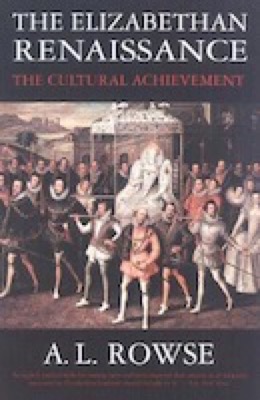
Author: A. L. Rowse
(Ivan R. Dee)
The Elizabethan Renaissance: The Cultural Achievement
A. L. Rowse divides his study of Elizabethan achievements into nine essays, each an excellent overview of major accomplishments and prominent figures. Published in 2000 by Ivan R. Dee, this text is a valuable history and humanities reference.
The Elizabethan period is characterized by the problems and social upheavals that occurred as a result of the Reformation. Rowse condemns the destruction of property and art during the extremism of the iconoclastic movement.
“The Drama as Social Expression” discusses playwrights and events that surrounded their careers, such as building theaters and outbreak of the plague. Rowse not only analyzes the lives of dramatists, he puts the popularity of their plays in correct context and provides a unified perspective of history. He emphasizes society’s naturalness and the Elizabethan tendency not to repress emotion, attributing the expansion of drama to the growth of London.
Rowse describes Elizabethan acting as declamatory, gestural, and stylized. “The actor’s delivery was that of the orator, addressed to the audience even more than to the stage.”
His background on John Lyly is essential for those interested in Court society, a playwright whose career ended in the 1590s when the boys’ companies lost favor. Shakespeare learned from Lyly’s dialogue. Rowse praises Shakespeare for his ability to write anything and appeal to the general population. The transition from drama to literature occurred in 1616.
In “Language, Literature and Society” Rowse marks a new beginning with writers Sidney and Spenser in the 1580s. He discusses Shakespeare’s “bawdy” language and defines Marlowe’s contribution as an ability to “marry splendid verse to the stage.”
Lyly is often credited as the first English novelist. Our use of the word “euphemism” originates with this writer. Rowse describes George Chapman, Ben Jonson, and John Donne as geniuses who reacted against the “dominant Elizabethan” in poetry. Chapman he calls an intellectual with a hatred for the common man. Jonson he labels unromantic and satirical. Donne, he says, was a persecuted Catholic.
England led Europe in keyboard music, establishing the basis for Western technique. Rowse elaborates on many contributions in “Words and Music,” an essay that provides a good overview, along with details a musician might appreciate. Musical developments became coordinated with poetry. Rowse remarks, “One of the significant features of Renaissance music all over Europe was its impregnation by the music of the people in song and dance.”
The madrigal, though originating in Italy, was popular in England. The ballad was written over and over with different words. Art songs were more sophisticated and lyrics did not change. Lute songs and virginals for the keyboard became popular. Instrumental music was created during the Renaissance, and chamber music in the home resounded.
In “Architecture and Sculpture” Rowse discusses how an “insular society” felt the impact of the Renaissance. He describes English work as gauche experimentation. He believes accomplishments were integrated with foreign inspiration. Architecture saw its peak in the 1580s. It no longer exhibited obvious classical influences. The most significant book on architecture was published by Sir Henry Wotton in 1624.
“Painting” is a short chapter. “One cannot say that the English reached any high accomplishment in this field, though there was an enormous amount of it, for the Elizabethans disliked blank spaces,” Rowse writes.
In “Domestic Arts” he explores applied arts such as embroidery, tapestry weaving, and furniture. Embroideries were used in costume and furnishing. Books had embroidered bindings. Even carpets with linen embroidery on canvas were popular. Gentry demanded heraldic panels on cushion covers. Costumes were a reflection of class and rank. Rowse describes Elizabethan furniture as “sparse and somewhat sombre.” People left oak pieces in their natural state.
“Science and Society” provides an overview of notable scientists and achievements. Rowse asserts that wise men led the blind in a time when most remained ignorant. Class differences prevented certain men, and particularly women, from pursuing education. Structured society frowned on disturbing accepted traditions that benefited a small percentage of the population while the majority suffered.
Improvement in the quality of maps and oceanic navigation changed the world. English mariners learned from the Portuguese and the Spanish, translating their textbooks. Rowse classifies Thomas Hariot as the most original scientific intellect among the Elizabethans. Hariot studied cartography and in 1585-1586 accompanied Raleigh to the first American settlement in Roanoke colony.
Dr. William Gilbert, a leading London physician, laid the foundations of electrical science and researched gravitation. Rowse disputes the common opinion of Bacon, claiming this scientist opposed simple induction and preferred the method of elimination.
“Nature and Medicine” discusses naturalists, doctors, and diseases. England was behind Italy, France, and Germany in medical science and city sanitation. Unsanitary practices, rats, and exposure to soldiers returning from the Netherlands in 1563 and 1603 led to the two heaviest epidemics of the plague. The last major outbreak was in 1665. Better hygiene and sanitary methods may have played a part. Evidence of severe psychological and physical incapacitation can be seen in literature. Treatment of gunshot wounds increased in importance, while psychiatry emerged as a new profession.
One of Rowse’s most informative chapters is “Mind and Spirit.” He examines theologians and philosophers, particularly those who advanced the Reformation. “Observe that, in the realm of religion and theology, the sixteenth century spent most of its mental energy on dispute,” Rowse states.
He points out that playwright Christopher Marlowe had been labeled an atheist, when in reality the writer had an “impersonal, cosmic conception of deity.” Anyone not an orthodox was considered an unbeliever. Rowse asserts the conflict between Reformation and Counter-Reformation set back intellectual progress rather than advancing it, and “tolerance came only with the relaxation of belief.” He sees Puritanism as an obstruction. At the root of the dispute may have been the Calvinist doctrine of predestination.
Rowse believes the Church of England is an idiosyncratic combination of Catholic and Protestant. His thesis points toward the Reformation as the cause of problems, whereas other historians see the Reformation as an attempt to solve them.
Academic Review - Shakespearean Negotiations
February/01/2017 03:44 PM
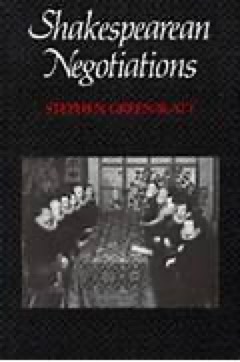
Author: Stephen Greenblatt
(University of California Press)
Shakespearean Negotiations
Stephen Greenblatt’s compilation of five essays discusses aspects of Renaissance society demonstrated in Shakespeare’s plays, four of which focus on a major genre. His book is a good secondary source, a mixture of literature and history. Published in 1988 by the University of California Press, this title is a reference for Elizabethan studies.
“The Circulation of Social Energy” serves as an introduction. Greenblatt defines “social energy” as the ability to arouse emotions or reactions across a broad spectrum. Other critics have used the term “universal” to describe Shakespeare’s talent in communicating beyond his own time. He explains how the playwright succeeded in moving concepts from one place to another, across shifting boundaries.
Greenblatt addresses a dynamic exchange between culture and time: “Power, charisma, sexual excitement, collective dreams, wonder, desire, anxiety, religious awe, free-floating intensities of experience…”
“Invisible Bullets” discusses Shakespeare’s history plays. The title refers to a reference by Native Americans to English colonists who exposed them to diseases for which they had no immunities. Since the Elizabethan audience found history and politics interesting, Shakespeare capitalized on the opportunity to present his unique mix of historical fact and engaging drama. The playwright’s work is an interpretation of events found nowhere else.
Greenblatt states that his plays are concerned with the production and containment of subversion and disorder. “Elizabethan playing companies contrived to absorb, refashion, and exploit some of the fundamental energies of a political authority that was itself already committed to histrionic display and hence ripe for appropriation.”
“Fiction and Friction” is an essay on sexual identity and the humorous situations in romantic comedies. In Elizabethan England, boys acted the roles of women, leading to contemporary discourse about sexuality.
According to Greenblatt, Shakespeare’s comedies contain sexual energy. The playwright used this erotic power in the development of plots that would interest an audience, so the “heat” takes place internally… out of sight… in the imagination. Shakespeare found ways to present sexual friction in his dialogue and in situational tension.
In the fourth work, “Shakespeare and the Exorcists,” Greenblatt provides background on the staging of exorcisms. During the Renaissance, educated people knew demonic possession was contrived, used as a tool to manipulate, or sometimes, a manifestation of mental illness. Within Shakespeare’s work, especially his tragedies, exorcism was equated with fraud and illusion, often perpetrated by the church.
Revealing is the significance of exorcism in Renaissance England. Spiritual possession is an issue rarely discussed in the twenty-first century. In Shakespeare’s time, the strangeness of this phenomenon puts it into the present-day category of Ripley’s Believe It or Not.
“Martial Law in the Land of Cockaigne” is an unusual essay on the use of anxiety and terror and its manifestation in Elizabethan drama. “The Tempest” is a primary example. The play is filled with mysticism and superstition, instigated by imagined and real threats. These tactics, as seen in Shakespeare’s work, were part of the Renaissance.
The culture and social energy of Renaissance society will never die. Not all writers were capable of keeping this life force alive, but Shakespeare succeeded.
Academic Review - An Oxford Guide: Shakespeare
January/23/2017 10:55 PM
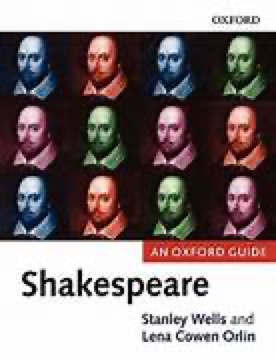
Author: Stanley Wells and Lena Cowen Orlin
(Oxford University Press)
An Oxford Guide: Shakespeare
This book is an excellent secondary reference source. Stanley Wells and Lena Cowen Orlin present an overview of Shakespeare’s career from historical and literary standpoints, providing detailed bibliographies. Numerous experts contributed, creating an unbiased collection of theses. Published in 2003 by Oxford University Press, this compilation is similar to an encyclopedia. Divided into four parts, the text covers Shakespeare’s life, genre, criticism, and afterlife.
Martin Ingram, a professor at Brasenose College, writes an interesting essay titled, “Love, Sex, and Marriage.” Despite the Renaissance notion that marriage is preferable, the statistical reality was nothing close to what church leaders and conservatives proposed. Pressure for a woman to marry, and unfortunate consequences of coerced or thwarted unions, drove much of Shakespeare’s drama, comedy, and tragedy.
“Demographic calculations indicate that at any given moment in this period up to forty-five percent of women were either not yet married or widowed, while the proportion of women who never married was on the increase and was to exceed one in five shortly after Shakespeare’s death,” Ingram writes.
Though experts state the playwright’s work surpasses time and place, Ingram does not take scenes out of Elizabethan context. “While many of the issues still have enormous resonance in the present day, they can be fully understood only in the very different cultural context of Shakespeare’s own time.”
Shakespeare was perceptive and saw women’s rights advocates emerge long before the majority took feminist concerns seriously. Likely, he could foresee the long-term impact of his dramatic statements, and it is certain he anticipated upheaval and transition.
William C. Carroll, a professor at Boston University, presents “Romantic Comedies,” an overview of Shakespeare’s strongest plays and a lighthearted reflection of English Renaissance society. “The romantic comedies are termed ‘romantic’ in part because their plots and major themes involve love and desire,” Carroll explains. “They are related to the so-called ‘romances’ in that both types of play have similar plots, typically involving some frustration of true love, a journey by a lover, improbable or even magical events, and a resolution in marriage or the promise of marriage arising from some discovery about identity.”
This winning formula drew audiences to the theater in the sixteenth and seventeenth centuries, and today, mesmerizes people at the cinema. Romance novels, trashed by critics as frivolous, utilize plot structure familiar to Shakespeare. The playwright’s misunderstandings, mistaken identities, and unlikely scenarios are hailed as creative art, yet contemporary writers dare not proceed along the same plot lines.
Though scholars are aware Shakespeare practiced his craft for money, academics ignore the monetary aspect. The college crowd appealed to Shakespeare—many were his comrades—but he acquired his education through independent reading and experience. His success is not based on how much he knew, but on how much he sold.
Bruce R. Smith, a professor at Georgetown University, contributes a thesis titled, “Studies in Sexuality.” The Elizabethan audience may have been different in mores and morals, but people manifested timeless instincts. “Bodies are as essential to plays in performance as electric signals are to videos. Actors have bodies, listeners/spectators have bodies, and the transactions among them in the course of a performance are energized by various forms of desire,” Smith says.
Libido and need to create a suitable environment to raise children influence the behavior of both genders, providing an eternal basis for plots. By placing obstacles to fulfillment, stories can be manipulated, scene after scene, until the couple does or does not reach the culmination.
David Kathman, a freelance scholar, debates the legitimacy of Shakespeare’s byline in “The Question of Authorship.” He makes a convincing case against those who claim Shakespeare did not write the works we now attribute to him. Numerous theories have denied the authenticity of the name “William Shakespeare,” even asserted the Bard was someone else. Some believe a group of playwrights and poets wrote under one name.
“Anti-Stratfordians try to discount the evidence for Shakespeare’s authorship using a variety of tactics, most of which involve distorting the facts and their historical context,” Kathman states. “In addition to replacing evidence with conspiracy theories, anti-Stratfordians usually attack Shakespeare personally, sometimes quite viciously. They depict Stratford as an uncultured cesspool which could never have produced a great writer, and Shakespeare himself as a greedy, semi-literate burgher.”
Although the playwright did collaborate with other writers on a few plays, the academic community does not take the authorship question seriously. “For most anti-Stratfordians, these attacks on William Shakespeare of Stratford have one primary purpose: to clear the way for their own candidate as the ‘real’ Shakespeare,” Kathman adds.
Social life and love in Renaissance England infiltrate every scene and every line of Shakespeare’s canon. Continued evaluation of this famous man brings to light modern attitudes toward the Elizabethans, what we’ve learned from them, and what we condemn in their behavior. This obsession with every word he wrote has led to new discoveries, while scholars enlighten one another with conjecture.
Would Shakespeare have appreciated this excessive pondering? No one will know for certain, but this acclaim has kept his name alive.
Academic Review - Everyday Life in Renaissance England
January/12/2017 12:21 PM
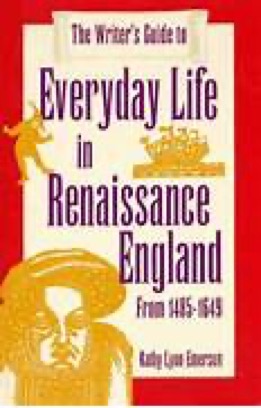
Author: Kathy Lynn Emerson
(Writer’s Digest Books)
The Writer’s Guide to Everyday Life in Renaissance England from 1485-1649
This reference tool is a compilation of essential information for writers. Kathy Lynn Emerson researched and consolidated her material into three sections and twenty succinct chapters. Her work is a documented secondary source with extensive bibliographies. She provides a select list for every topic. Fiction writers, in particular, will find this book useful. She includes details historians may gloss over as unimportant, all necessary to create realism in a short story or a novel. For Elizabethan drama or Renaissance history students, this guide can be utilized like an encyclopedia. Published in 1996 by Writer’s Digest Books, the text is packed full of trivia.
Divided into three parts, the book starts with Everyday Life, a section that includes clothing, accessories, food, drink, architecture, furnishings, marriage, family, health, and physicians. “Physic and Physician” is Emerson’s most enlightening chapter, providing a down-to-earth perspective on English Renaissance medicine. She begins this chapter discussing the widespread notion that disease was caused by supernatural forces. Although people acknowledged natural causes, they didn’t know that malnutrition and poor sanitation led to illness. Emerson writes, “Epidemics were regarded as God’s punishment for man’s sins.”
The Barber-Surgeons was the first medical guild in England. They engaged in procedures such as blood-letting, minor surgery, pulling teeth, cutting hair, and shaving. The apothecaries (pharmacists) were affiliated with the grocers. Doctors received degrees after years of schooling. Alarming is their method of study. The use of cadavers was not prevalent, so interns did not gain hands-on experience.
“Medical students did not often come in direct contact with patients. They read old books, attended lectures and got their degree by ‘spoken disputation,’” Emerson explains. “A man’s humour (sanguine, choleric, phlegmatic or melancholic) played an important role in treating his ailment. Physicians relied heavily on water casting, the diagnosis of the balance of the humours by examination of the patient’s urine.”
The most lethal disease during the Renaissance was the plague. There were numerous outbreaks and smaller epidemics. Emerson states that outbreaks started in early summer and ended in November, with a fatality rate of sixty to eighty-five percent for the unfortunate people who contracted the Bubonic form. Among the most absurd preventive treatments: the practice of drinking mummy, which was dry, dead human flesh. Another strange procedure was wearing arsenic next to the skin. Burning old shoes? They were thought to have purifying fumes.
The treatment of common ailments could lead to a patient’s death, and if not fatal, these “cures” were enough to make a sick person even sicker. For example, asthma was treated with wine in which woodlice had been steeped. An infertile woman drank an elixir from mare’s milk, rabbit’s blood, and sheep’s urine. She probably wouldn’t have had much of an appetite for anything, including sex, after swallowing this cocktail. A patient with a toothache was thought to have worms or “unbalanced humours” and chewed horehound root.
Emerson’s second part, Government and War, is a compilation of chapters that constitute a historical overview: government, monarchs, nobles, commoners, crime, punishment, money, war, peace, and seafaring. “A Seafaring Nation” will appeal to those looking for adventure. In our age of high-speed air travel, the slow, dangerous contrast of living on a filthy ship for months makes a several hour flight with airport delays seem like heaven.
Emerson starts with a description of life at sea. The closer the ship was to shore, the better their diet. On prolonged voyages, the crew relied heavily on beef and pork cured in brine, along with rotten biscuits and fresh fish. Even porpoise was boiled or fried. Lack of vegetables and fruits led to scurvy, a disease characterized by fatigue, body aches, and loose teeth. A typical ration was one gallon of beer, one pound of biscuit, and two pounds of pork and peas, four days a week. Those who sailed were likely intoxicated.
Sanitary conditions were poor. The ship would have smelled like human excrement and urine with rats and roaches running wild. Most vessels leaked, so drippy areas were stuffed with clothes and animal hides and sailcloth. “Mariners were constantly wet,” Emerson explains. “Cold water not only sloshed in the bilges with the constant rolling of the ship, it also dripped down through leaking decks and topsides. After storms, there were always more leaks.”
To make the hellish environment worse, people onboard were superstitious. Sailors did not learn how to swim to inspire confidence, a ridiculous way to flaunt navigational skills. “Storm-driven ships were believed to be bewitched and anyone suspected of being a witch might be thrown overboard,” Emerson writes. “Evil could also be driven away by nailing two red-hot horseshoes to the main mast.”
After thirty days at sea with high waves and brutal winds, a drunk, sick officer could blame an unsuspecting individual on the ship for his woes and toss the person to the sharks. Part of this erratic behavior and psychotic paranoia could have been induced by nutritional imbalances and untreated illness. The longer the voyage, the longer the agony, so only the mentally stable could work at sea.
Emerson’s distinction between privateers and pirates is essential to understanding Elizabethan England. A simplistic definition might designate one good and one bad, or one legal and one illegal. Unfortunately, the definition is blurred and would depend on national loyalty. Often hired by the government, a privateer is employed to rob and pillage from specifically designated ships. A pirate is a criminal. Or, another way of stating that a pirate acted on his own behalf. Piracy was illegal, but few were tried or hung.
Emerson reveals the local gentry often financed their escapades. “The practice of privateering predates the creation of all national navies,” she says. “By the start of the sixteenth century, privateers were regularly used to augment the English navy.”
Romanticized today, marauders fill the pages of historical fiction. With questionable integrity, these bad guys (and a few gals) made history for leading lives out of the ordinary. Nothing films better and plays better on a stage or in the pages of a novel.
In Renaissance Society, the third and longest section, Emerson discusses education, employment, entertainment, language, urban and rural life, travel, and superstition. “Witches, Magic, Necromancy and Superstition” describes a world with crazy laws based on inner fears, church-induced phobias, and insufficient education. Fortunately, today we don’t turn on the news and hear about the execution of a woman with supernatural power.
Beginning with the English witch trials, Emerson writes of this strange phenomenon during the Elizabethan period. When people feel they cannot control life, they often blame a circumstance or another human being. Although passing the buck is common in our time as well, in Renaissance England this natural tendency escalated to lunacy. Most envision women tied to stakes and burned for indefinable crimes or curses.
In England, witches were not burned, but hung. Religious fanaticism was the basis for this insanity. By 1579, church officials looked for birthmarks on the body to determine whether a woman was possessed by the devil. Desperately needing an explanation for a death in a family or a scapegoat for a streak of bad luck that may have befallen a village, these men of God could give suspicious women, many of them widows, the death sentence.
According to Emerson, informational pamphlets about what witches did were distributed to the public. “They were some of the most popular reading matter of their day,” she remarks. “Essex held more witch trials than elsewhere in England. About 250 cases were tried between 1560 and 1600, but not all of these witches were executed. Many were punished by public penance or jail time. Throughout England, the percentage of trials ending in conviction varied but the high was 42 percent during the period from 1645 to 1647.”
In France, ninety-five percent of trials turned into convictions. Those executed were burned at the stake for heresy under the dictates of the Catholic Church.
Tragically, the same hysteria emerged in Colonial America during the Salem witch trials. Like the English and French, colonists looked for sinister behavior among women and accused innocent citizens of crimes they had never committed. Where no proof of witchcraft existed, ministers of established rank fabricated evidence.
Emerson writes, “Under Roman law, sorcery was only a crime if it was practiced with evil intent and caused damage. However, after 1541, prognostication and other kinds of sorcery, including using magic for treasure-seeking or to recover stolen goods or to provoke unlawful love, became felonies without benefit of clergy.”
This reference guide is fascinating as well as educational and every bit as riveting as an action novel. Without the bias typical of some scholars, Emerson presents facts in a straightforward manner.